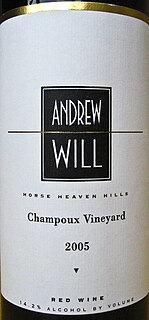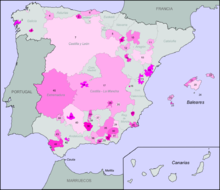The Abadia Retuerta is a Spanish winery founded in 1996. The estate is situated just outside the border of the Ribera del Duero region in Spain’s north central province of Castilla y León, near the village of Sardón del Duero. Twenty miles east of the city of Valladolid, it lies in wine estates stretching from Tudela de Duero to Peñafiel known as “the golden mile”. Notably, it is just a few miles from Vega Sicilia, producer of Unico (wine).

Méntrida is a Spanish Denominación de Origen Protegida (DOP) for wines covering many municipalities in the northeast corner of the province of Toledo and which is divided into three distinct areas: Talavera, Torrijos and Sagra-Toledo, with over 26,000 hectares under vines, the majority (71%) being in Torrijos.

Vinos de Madrid is a Spanish Denominación de Origen Protegida (DOP), located in the southern part of the region of Madrid (Spain). It covers 54 municipalities and is divided into the three sub-zones, each of which produce different types of wine.

Mondéjar is a Spanish Denominación de Origen Protegida (DOP) for wines located in the southeast corner of the province of Guadalajara, around the town of Mondéjar. It covers 19 municipalities, the most important one being Sacedón.

Ribera del Júcar is a Spanish Denominación de Origen Protegida (DOP) for wines located in the province of Cuenca along the banks of the River Júcar and covers 7 municipalities.

Valdepeñas is a Spanish Denominación de Origen Protegida (DOP) for wines located in the province of Ciudad Real in the south of Castile-La Mancha (Spain). It is almost completely surrounded by another DOP but is an independent DOP due to its long history of producing a distinct style of wine known aloque or clarete which is made by mixing white and red grapes. 2016´s harvest is formed by 55.9 million kilos of red grapes and 43.2 million kilos of white grapes.

Costers del Segre is a Spanish Denominación de Origen Protegida (DOP) for wines located in the province of Lleida and is divided into several separate sub-zones. The four original subzones created in 1988 are Artesa, to the northeast of Lleida, Valls de Riucorb to the east, Garrigues and Raïmat. In 1998 two other subzones were added: Pallars Jussà, next to the town of Tremp, 90 km north of Lleida and Segrià to the west and surrounded by the Raimat subzone.

Utiel Requena is a Spanish Denominación de Origen Protegida (DOP) for wines located in the province of Valencia. It takes its name from the two neighbouring towns of Utiel and Requena. It is renowned for the predominant use of the Bobal grape variety.
Guijoso is a Vino de Pago from Spain. This is the highest category on the quality scale of Spanish wines and means that in addition to having a proven track record of consistent quality, the wines have to be both produced from estate-grown grapes and also have to be processed and aged in a winery (bodega) located on the estate.

Navarra is a Spanish Denominación de Origen Protegida (DOP) for wines from the southern half of the autonomous community of Navarre. The vineyards are on the lower slopes of the Pyrenees as they descend towards the basin of the river Ebro.
Finca Élez is a Vino de Pago from Spain. This is the highest category on the quality scale of Spanish wines and means that in addition to having a proven track record of consistent quality, the wines have to be both produced from estate-grown grapes and also have to be processed and aged in a winery (bodega) located on the estate. This Vino de Pago is located in the municipality of El Bonillo, in the province of Albacete and acquired its status in 2002.
Dehesa del Carrizal is a Vino de Pago from Spain. This is the highest category on the quality scale of Spanish wines and means that in addition to having a proven track record of consistent quality, the wines have to be both produced from estate-grown grapes and also have to be processed and aged in a winery (bodega) located on the estate.

Arlanza is a Spanish Denominación de Origen Protegida (DOP) located in the provinces of Burgos and Palencia, Castile and León, Spain. It was officially upgraded from the lower status of QWPSR in 2007. The DOP covers 67 municipalities. There are 23 wineries (bodegas) from Burgos registered and 2 from Palencia. The DOP takes its name from the river Arlanza which flows through it.

Uclés is a Spanish Denominación de Origen Protegida (DOP) for wines located in the region of Castile-La Mancha, (Spain), around the town of Uclés in the west of the province of Cuenca and in the northeast of the province of Toledo.

Abanilla was a Spanish geographical indication for Vino de la Tierra wines located in the autonomous region of Murcia. Vino de la Tierra is one step below the mainstream Denominación de Origen indication on the Spanish wine quality ladder.
Campo de la Guardia is a Vino de Pago from Spain. This is the highest category on the quality scale of Spanish wines. In addition to having a proven track record of consistent quality, these wines must be both produced from estate-grown grapes and also processed and aged in a winery (bodega) located on the estate.

Champoux Vineyard is a grape growing estate located in the Horse Heaven Hills AVA of Washington state. Grapes grown in the vineyard have been used to produce some of the most critically acclaimed Washington wines with the name Champoux regularly being featured on vineyard designated wines. Paul Gregutt, wine writer for the Seattle Times and Wine Enthusiast, list Champoux as one the "top ten" vineyards in the entire state. Cabernet Sauvignon grapes from Champoux vineyards were featured in the consecutive 100 point Robert Parker rated wines from Quilceda Creek Vintners for the 2002 and 2003 vintages.
Pago Florentino is a Vino de Pago from Spain. This means that in addition to having a proven track record of consistent quality, the wines have to be both produced from estate-grown grapes and also have to be processed and aged in a winery (bodega) located on the estate.

Force Majeure is a Washington/Oregon wine estate, specializing in the growing and production of premium Syrah, Cabernet Sauvignon as well as other Bordeaux and Rhone-inspired blends. The brand was founded in 2004, and beginning with that vintage Force Majeure began the "Collaboration Series" of wines made by some of Washington's top winemakers, using fruit from Red Mountain's Ciel du Cheval vineyard, garnering much critical acclaim and attention for the brand.
IGP Murcia is a Spanish geographical indication for Vino de la Tierra wines located in the autonomous region of Murcia. Vino de la Tierra is one step below the mainstream Denominación de Origen indication on the Spanish wine quality ladder, and mirrors the Vins de pays of French wine. It acquired its Vino de la Tierra status in 2011.















